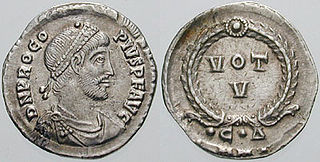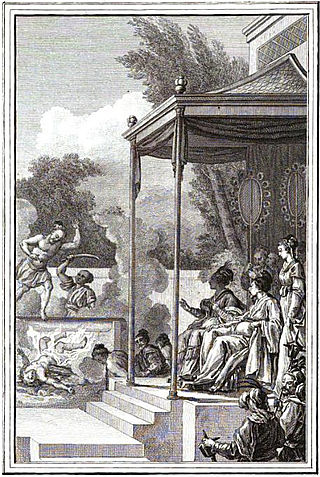Year 385 (CCCLXXXV) was a common year starting on Wednesday of the Julian calendar. At the time, it was known as the Year of the Consulship of Augustus and Bauto. The denomination 385 for this year has been used since the early medieval period, when the Anno Domini calendar era became the prevalent method in Europe for naming years.
The 380s decade ran from January 1, 380, to December 31, 389.

Year 427 (CDXXVII) was a common year starting on Saturday of the Julian calendar. At the time, it was known as the Year of the Consulship of Hierus and Ardabur. The denomination 427 for this year has been used since the early medieval period, when the Anno Domini calendar era became the prevalent method in Europe for naming years.
The 360s decade ran from January 1, 360, to December 31, 369.

The 1st millennium BC, also known as the last millennium BC, was the period of time lasting from the years 1000 BC to 1 BC. It encompasses the Iron Age in the Old World and sees the transition from the Ancient Near East to classical antiquity.

Year 365 (CCCLXV) was a common year starting on Saturday of the Julian calendar. At the time, it was known in the West as the Year of the Consulship of Augustus and Valens. The denomination 365 for this year has been used since the early medieval period, when the Anno Domini calendar era became the prevalent method in Europe for naming years.

Xie Lingyun, also known as the Duke of Kangle (康樂公), was one of the foremost Chinese poets of the Southern and Northern Dynasties and a famous practitioner of the Six Dynasties poetry.

Tao Yuanming, also known as Tao Qian, was a Chinese poet and politician who was one of the best-known poets during the Six Dynasties period. He was born during the Eastern Jin dynasty (317–420) and died during the Liu Song (420–479) dynasty. Tao Yuanming spent much of his life in reclusion, living in the countryside, farming, reading, drinking wine, receiving the occasional guest, and writing poems in which he often reflected on the pleasures and difficulties of life, as well as his decision to withdraw from civil service. Tao's simple and direct style was somewhat at odds with the norms for literary writing in his time. In the Tang dynasty (618–907), he was well known as a recluse. During the Northern Song dynasty (960–1127), influential literati figures such as Su Shi (1037–1101) declared him a paragon of authenticity and spontaneity in poetry, predicting that Tao Yuanming would achieve lasting literary fame. However, Tao Yuanming's inclusion in the 6th century literary anthology Wen Xuan argues for at least a beginning of fame in his own era, at least in his own birth area. Tao Yuanming would later be regarded as the foremost representative of what we now know as Fields and Gardens poetry. Tao Yuanming found inspiration in the beauty and serenity of the natural world close at hand. Tao Yuanming is depicted in the Wu Shuang Pu by Jin Guliang.

Ancient literature comprises religious and scientific documents, tales, poetry and plays, royal edicts and declarations, and other forms of writing that were recorded on a variety of media, including stone, clay tablets, papyri, palm leaves, and metal. Before the spread of writing, oral literature did not always survive well, but some texts and fragments have persisted. One can conclude that an unknown number of written works too have likely not survived the ravages of time and are therefore lost.

Three laughs at Tiger Brook is a Chinese proverb which refers to the image that the three men, Huiyuan, Tao Yuanming and Lu Xiujing laugh together when arriving at Huxi of Mount Lu. This concept represents the ideal harmonious relations of Confucianism, Taoism and Buddhism in ancient China.
Six Dynasties poetry refers to those types or styles of poetry particularly associated with the Six Dynasties era of China. This poetry reflects one of the poetry world's more important flowerings, as well as being a unique period in Classical Chinese poetry, which, over this time period, developed a poetry with special emphasis on romantic love, gender roles, and human relationships. The Six Dynasties era is sometimes known as the "Age of Fragmentation", because China as a whole through this period lacked unification as a state, at least for any extended period of time; and, instead, many states rose and fell, often overlapping in existence with other states. Which of the various states and dynasties constituted the "6" dynasties of the Six Dynasties period varies somewhat according to which of the traditional selection criteria are chosen. The Six Dynasties era covers several somewhat overlapping main periods including all of the following: the Three Kingdoms (220–280), Jin dynasty, the Sixteen Kingdoms, and the Southern and Northern Dynasties (420–589). Sometimes, chronological discrepancies occur in regard to the turbulent political events of the time, from which these traditional historical-era designations derive, together with the somewhat different chronology of poetic developments. Thus, neither the lives of the poets nor the trends in their poetry fit gently and neatly together with these period dates. Furthermore, conversions to the Common Era dating system can create further complications. However, regardless of the chronological difficulties, major developments of poetry during the Six Dynasties include formalizing the distinction between the Jian'an era regular yuefu and the shi style poetry, further development of the fu, theoretical work on technique, and the preservation of both Six Dynasties and earlier poetry by collecting and publishing many of the pieces which survive today into various anthologies consisting all or in part of poetry.
Fields and Gardens poetry, in Chinese poetry, is a poetic movement which sparked centuries of poetic enthusiasm, generally considered to effectively date from the Six Dynasties era. Both the Chinese Landscape poetry and the Fields and Gardens poetry share a common theme of nature foremost with human beings and human thought seemingly not in main focus; however, in the case of the Fields and Gardens genre the nature that was focused upon was more domestic—the nature found in gardens, in backyards, and in the cultivated countryside. Sometimes, the poems were designed to be viewed with a particular work of art, others were intended to be "textual art" that invoked an image inside a reader's mind. Fields and Gardens poetry is one of many Classical Chinese poetry genres.

Boyi and Shuqi were two Dongyi brothers from Guzhu, a Dongyi vassal state under the Shang Dynasty. According to tradition, they lived at the time of the transition between the Shang dynasty and the Zhou dynasty. They are remembered in literary culture for their personal and moral virtue, loyalty, and pacifist idealism. Sometimes they are referred to together just as "Boyi", after the elder brother.
Trees in Chinese mythology and culture tend to range from more-or-less mythological such as the Fusang tree and the Peaches of Immortality cultivated by Xi Wangmu to mythological attributions to such well-known trees, such as the pine, the cypress, the plum and other types of prunus, the jujube, the cassia, and certain as yet unidentified trees. Mythological ideas about trees also extends to various types of fungi which lived or were thought to live underneath certain of these trees, collecting their mysterious essences.







